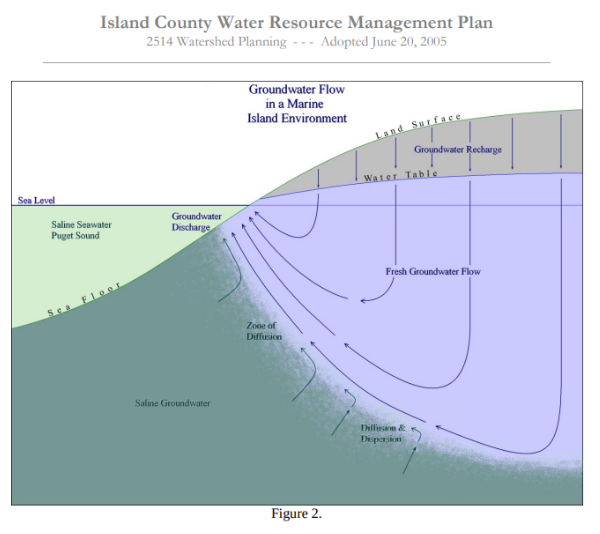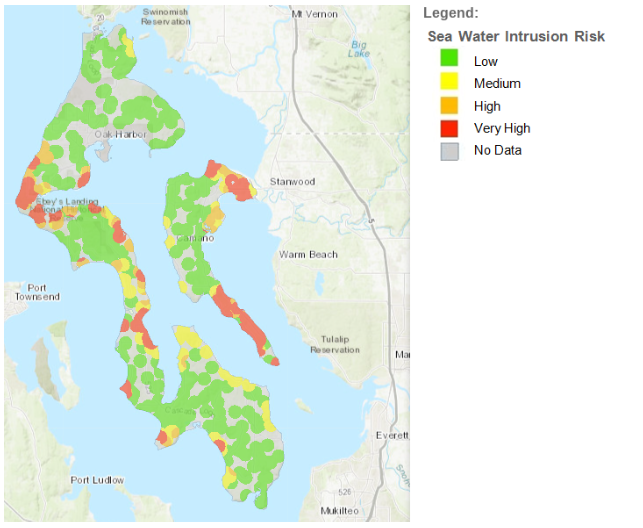Water Quality on Whidbey Island: Insights and Solutions for Sustainable Living.
- Simona
- Feb 7, 2024
- 4 min read
The natural flow of freshwater into saltwater is generally untroublesome; the challenge lies in preventing the reverse flow.
Kudos if you're connected to the city water supply in Oak Harbor! Your water supply may trace its origins beyond the island. Thanks to Anacortes and the Skagit River, a portion of Whidbey's water is transported through pipelines from a river originating in the mountains. Depending on the season, you might be savoring water that has recently melted from snow. While there is minimal risk of salt in this water, there could be natural minerals, at least at its source. Explore more about water quality on Whidbey Island in this blog.

The visual landscape is adorned with a multitude of icons, creating an intricate tapestry. For an interactive map, click HERE. There's scarce open land to gaze upon; dots abound. Yet, this is not a cause for concern. Well, water is widespread, serving many homes through community and municipal wells. Residing here may not feel much different from enjoying piped water in Oak Harbor; the only distinction is that the pipe doesn't have to traverse as far.
A notable sign at the neighborhood's border serves as an indicator of any deviations—whether the water supply is operating under normal conditions or subject to rationing, a consequence of occasional droughts.
Homeowners in more secluded locations cultivate a keen awareness of their water source, often having a well on their property. The more refined wells reside in diminutive structures, typically distanced from the main residence, septic system, and other buildings. It's at this juncture that the potential mingling of waters becomes apparent.
In the natural course, rainwater descends, finding its way by either running off the land or infiltrating it. While rivers and streams serve as conspicuous conduits for runoff, sometimes rainwater hovers just beneath the surface. It continues to flow, though not in the form of rivers or streams but in expansive sweeps. Moreover, water permeates deeper into the ground, filling and nourishing subterranean aquifers—precisely the reservoirs that wells tap into.

Aquifers function as concealed reservoirs and natural conduits, adept at gathering and directing rainwater. This phenomenon is not exclusive to islands. Farms across the expansive Great Plains, for instance, delve into extensive aquifers. Island aquifers, while comparatively smaller, maintain an air of mystery. Questions arise about the type of soil they occupy—both beneath and within. The extent of their size, depth, and water capacity remains enigmatic. Does a singular aquifer exist, or are there multiple interconnected ones contributing to this subterranean network? Thus, the need for drilling arises. Over the years, individuals seeking to develop land have been required to consult with the County to determine if there's an existing well or a possibility of sharing one. If not, they must engage the services of a well-digger and hope for success.
Every aquifer has its limits on the amount of water that can be extracted from it. While this may appear evident in hindsight, the reality is that extracting too much freshwater can lead to the infiltration of surrounding saltwater. The outcome can either be a successful "voila" moment or an unfortunate "oops," where a freshwater supply runs dry or turning on a tap results in the flow of salty water.
The likelihood of saltwater infiltrating a freshwater well was lower for the early settlers. This occurrence was more probable if a well was drilled near the shoreline, particularly if it was a shallow well. The threat of seawater intrusion is no longer a distant concept. A quick examination of the island's map, available for interactive exploration by clicking HERE, reveals several marked locations at risk of such intrusion. Some of these spots are already grappling with the challenges posed by seawater encroachment.

The risk of seawater intrusion can serve as a deterrent to further development in certain neighborhoods. While vacant land may appear enticing, the inability to access water could render it unsuitable for constructing a habitable dwelling. The concept of 'water shares' and fees associated with tapping into limited supplies often emerge. Resorting to drilling another well is not a viable solution, as it poses the risk of drawing in more seawater.
Whidbey Island's highest point reaches approximately 500 feet above sea level, and some wells extend several hundred feet below sea level. However, when executed properly, with consideration to the right aquifer and a pumping rate below specified thresholds, potential issues may be averted. While reveling in freshwater access, a careful analysis of the map, ideally with the guidance of a broker, can help identify areas with concerns and restrictions.
Certainly, the alteration in water taste is not exclusively attributed to seawater intrusion. Well water, being a natural source, inherently carries minerals from the ground. Consuming water from an underground aquifer can impart a distinctive flavor derived from the minerals it has filtered through. This nuance is duly noted by chefs, cooks, and food enthusiasts who value the use of natural water and its inherent flavor profile. While some may perceive it as an enhancement, others might find it a reason to opt for filtered water through purchases or deliveries.
The minerals contributing to the hardness of the island's water include Arsenic, Calcium, Chloride, Hardness, Iron, Potassium, Magnesium, Manganese, Nitrate, Phosphorus, Sodium, and Sulfate. Household systems can be installed to tailor the water to better match individual preferences. Options range from simple countertop pitchers with filters to larger systems housed in separate sheds, especially if they are noisier or larger than what an owner desires within their residence. For assistance, consult your broker for recommendations on professionals who can help address your specific needs.
Both private and public entities offer testing services for a range of chemicals. Your personal sensitivities play a crucial role in evaluating the quality of water. Have you ever been prompted to sample the water during a home inspection or when contemplating making an offer on a property? On Whidbey Island, it's an advisable step to take!
Fortunately, our knowledge has significantly expanded in recent decades. The government has made substantial progress in accurately measuring and assessing the situation. Speculation is giving way to concrete answers, thanks to the development of technologies and techniques that mitigate the risk of inadvertently drawing in seawater.
Комментарии